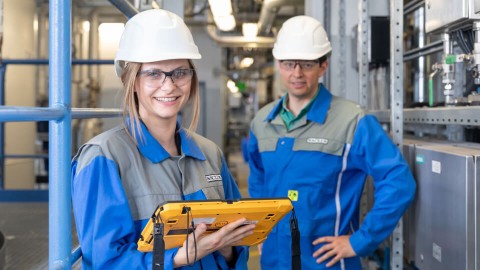VINNAPAS® CA 5588

VINNAPAS® CA 5588 is an aqueous polymer dispersion based on vinyl acetate and ethylene. It is particularly suited in carpet binder applications where a medium/ firm hand is required. The dispersion combines very high solids content with a low viscosity — a combination that permits the addition of very high filler loadings, resulting in adhesive formulations with high solid contents of 80 percent or even greater. VINNAPAS® CA 5588 is not produced with any added organic solvents, plasticizers or formaldehyde donors.
Properties
Data sheets
VINNAPAS® CA 5588 can take high filler loads with calcium carbonate or aluminium trihydrate (ATH) for compounding. Foaming additives and dispersing agents can be added to VINNAPAS® CA 5588 to improve foamability and filler acceptance. We recommend alkali-swellable poly(acrylic acid) derivatives. Products with neutral pH, e.g., those based on cellulose derivatives, poly(vinyl alcohol) or polyurethane, can also be considered. The compatibility and efficacy should be checked by conducting a storage test.
General VINNAPAS® CA 5588 can be used in the precoat and secondary coatings that are applied in the production of tufted carpet backings. It can also be used in the production of tufted carpet tiles and woven carpets. VINNAPAS® CA 5588 offers high adhesion strength, and good flexibility. Special VINNAPAS® CA 5588 can be applied by a number of different application methods including foaming (direct coating), pan coating, saturation and spraying. VINNAPAS® CA 5588 performs well on various fiber types including polypropylene, polyamide, cellulose, and polyester.
If the product is used in applications other than those mentioned, the choice, processing and use of the product is the sole responsibility of the purchaser. All legal and other regulations must be complied with.
For questions concerning food contact status according the chapter 21 CFR (US FDA) and German BfR, please feel free to contact us.
Wacker Chemie AGGisela-Stein-Strasse 1
81671 Munich
Germany
Storage
When the dispersion is stored in tanks, proper storage conditions must be maintained. The product has a shelf life of 9 months starting from the date of manufacture if stored in the original, unopened containers at temperatures between 5 and 30°C. Please refer to "Best use before date" on the packaging label. Storage beyond the date specified does not mean that the product can´t be used anymore, but the user should perform a quality check on the properties necessary for the intended application. Any longer periods for the maximum storage period that may be described in the Certificate of Analysis which accompanies each shipment of the product, take preference over this suggestion in which case the time period stated in the Certificate of Analysis shall be solely authoritative. Iron or galvanized-iron equipment and containers are not recommended because the dispersion is slightly acidic. Corrosion may result in discoloration of the dispersion or its blends when further processed. Therefore, the use of containers and equipment made of ceramics, rubberized or enameled materials, appropriately finished stainless steel, or plastic (e.g. rigid PVC, polyethylene or polyester resin) is recommended. As polymer dispersions may tend to superficial film formation, skins or lumps may form during storage or transportation. Filtration is therefore recommended prior to utilization of the product.
Preservation for Transport, Storage and further Processing
The product is adequately preserved during transportation and storage if kept in the original, unopened containers. However, if it is transferred to storage tanks, the dispersion should be protected against microbial attack by adding a suitable preservative package.
Measures should also be taken to ensure cleanliness of the tanks and pipes. In unstirred tanks, a layer of preservative-containing water should be sprayed onto the surface of the dispersion to prevent the formation of unwanted skin and possible attack by microorganisms. The thickness of this water layer should be < 5 mm for low viscosity dispersions and up to 10-20 mm for high viscosity products. Proper procedures - periodic tank cleaning and sanitization - must be set up in order to prevent microbial attack. Contact your biocide representative/supplier for further plant hygiene recommendations. Measures should be taken to ensure that only clean air enters the tank when the dispersion is removed.
Finished products manufactured from polymer dispersions usually also require preservation. The type and scope of preservation will depend on the raw materials used and the anticipated sources of contamination. The compatibility with other components and the efficacy of the preservative should always be tested in the respective formulation. Preservative manufacturers will be able to advise you about the type and dosage of preservative required.
Sales and support
Allentown, PA 18106-9346
United States
+1 517 264-4088 (Fax)
How can we help you?
- Do you need help in choosing a product or do you require technical support? If so, please contact our experts.


